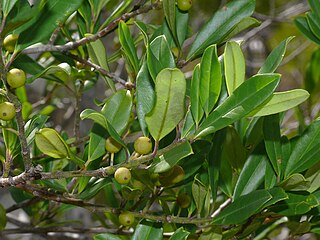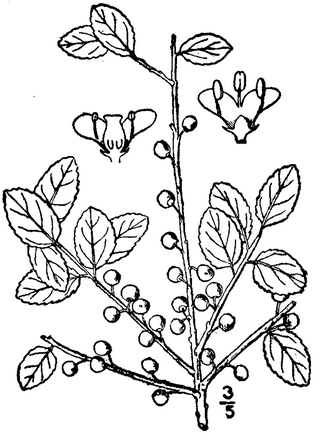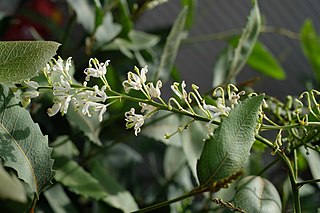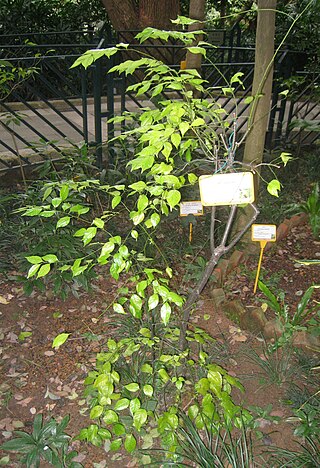
Ilex opaca, the American holly, is a species of holly, native to the eastern and south-central United States, from coastal Massachusetts south to central Florida, and west to southeastern Missouri and eastern Texas.

Ilex cassine is a holly native to the southeastern coast of North America, in the United States from Virginia to southeast Texas, in Mexico in Veracruz, and in the Caribbean on the Bahamas, Cuba, and Puerto Rico. It is commonly known as dahoon holly or cassena, the latter derived from the Timucua name for I. vomitoria.

Ilex vomitoria, commonly known as yaupon or yaupon holly, is a species of holly that is native to southeastern North America. The word yaupon was derived from the Catawban yą́pą, from yą- tree + pą leaf. Another common name, cassina, was borrowed from Timucua. The Latin name comes from an observation by early Europeans that the ingestion of the plant was followed by vomiting in certain ceremonies.

Ilex verticillata, the winterberry, is a species of holly native to eastern North America in the United States and southeast Canada, from Newfoundland west to Ontario and Minnesota, and south to Alabama.

Ilex crenata, the Japanese holly or box-leaved holly is a species of flowering plant in the family Aquifoliaceae, native to eastern China, Japan, Korea, Taiwan, and Sakhalin.

Ilex aquifolium, the holly, common holly, English holly, European holly, or occasionally Christmas holly, is a species of flowering plant in the family Aquifoliaceae, native to western and southern Europe, northwest Africa, and southwest Asia. It is regarded as the type species of the genus Ilex, which by association is also called "holly". It is an evergreen tree or shrub found, for example, in shady areas of forests of oak and in beech hedges. In the British Isles it is one of very few native hardwood evergreen trees. It has a great capacity to adapt to different conditions and is a pioneer species that repopulates the margins of forests or clearcuts.

Ilex montana, the mountain winterberry, is a species of holly native to the Eastern United States, ranging along the Appalachian Mountains from southeast Massachusetts to northeast Alabama and northern Georgia. Synonyms include Ilex monticola.

Ilex guayusa is a species of tree of the holly genus, native to the Amazon Rainforest. One of four known caffeinated holly trees, the leaves of the guayusa tree are harvested fresh and brewed like a tea for their stimulative effects.

Ilex glabra, also known as Appalachian tea, dye-leaves, evergreen winterberry, gallberry, and inkberry, is a species of evergreen holly native to the coastal plain of eastern North America, from coastal Nova Scotia to Florida and west to Louisiana where it is most commonly found in sandy woods and peripheries of swamps and bogs. Ilex glabra is often found in landscapes of the middle and lower East Coast of the United States. It typically matures to 5–8 ft (1.5–2.4 m) tall, and can spread by root suckers to form colonies. It normally is cultivated as an evergreen shrub in USDA zones 6 to 10.

Ilex decidua is a species of holly native to the United States.

Osmanthus heterophyllus, variously known as holly osmanthus, holly olive, and false holly, is a species of flowering plant in the olive family Oleaceae, native to eastern Asia in central and southern Japan and Taiwan.
Ilex brachyphylla is a type of holly - a species of plant in the family Aquifoliaceae. It is endemic to China where it grows as a shrub or small tree from 4 to 15 m in height. It has leathery glossy green leaves which have serrated edges and a sharp point. Although male flowers have been described, the Flora of China records that female flowers have not been observed and neither has the fruit. It is rare and an endangered species found only on mountain slopes in south-west Hunan province.

Ilex canariensis, the small-leaved holly, is an endemic species of holly native to Macaronesian islands. It is a species of plant in the family Aquifoliaceae. It is found in the Macaronesian islands of Madeira (Portugal) and Canary Islands (Spain).

Ilex, or holly, is a genus of over 570 species of flowering plants in the family Aquifoliaceae, and the only living genus in that family. Ilex has the most species of any woody dioecious angiosperm genus. The species are evergreen or deciduous trees, shrubs, and climbers from tropics to temperate zones worldwide. The type species is Ilex aquifolium, the common European holly used in Christmas decorations and cards.

Lomatia ilicifolia, commonly known as holly lomatia or native holly, is a plant in the family Proteaceae and is endemic to south-eastern Australia. It is a stiff, erect shrub with hairy, rust-coloured new growth and which recovers from fire from a lignotuber. It has dull green, leathery, prickly, holly-like leaves and long sprays of cream flowers, usually after fire.

Ilex cornuta, commonly known as Chinese holly or horned holly, is a slow-growing, densely foliaged evergreen shrub in the Aquifoliaceae plant family. It is native to eastern China and Korea and attains a height of about 3 metres (9.8 ft). The leaves are usually 5-spined, between 3.5 cm and 10 cm long, oblong and entire. The fruits are red berries, which are larger than those of the European Holly.

Ilex serrata is a species in the Ilex (holly) genus and the family Aquifoliaceae. It is an evergreen shrub or small tree up to about 4.5 m high. In Japan where it naturally occurs, it is a hardy species with ovate dark green leaves, pink flowers and red berries on the female plant.

Philippe Cuénoud is a Swiss entomologist and botanist living in Onex, who worked on the Psocoptera of Switzerland and Papua New Guinea, as well as on plant phylogeny. He found the only recently known population of Lachesilla rossica near Geneva and contributed further to the knowledge of the flora and fauna of the canton of Geneva with the first mention of a slender-billed gull and with the discovery of the first reported population of small-leaved helleborines. He also participated in a multidisciplinary study of the free-living fauna and flora of Basel's Zoo. In a 1999 trip to Brasil with Alain Chautems, he was among the first few people to see the newly rediscovered flower Sinningia araneosa, that had gone missing for more than a century.

Ilex asprella, also known as rough-leaved holly and plum-leaved holly, is a deciduous shrub native in South East Asia. Ilex asprella is one of the few deciduous species in the family Aquifoliaceae.
Susyn M. Andrews is a British taxonomic horticulturist. Her research has focussed on temperate and subtropical woody plants, especially Holly and Lavender.




















